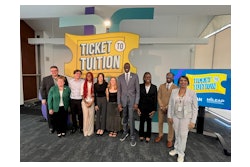Making Some Noise: The Academy’s Hip-Hop Generation
Scholarship on the genre moves beyond a project of legitimization into a more self-critical, challenging realm
A hip-hop archive at Harvard University? Classes at Berkeley, Stanford, Michigan, Yale and MIT? Panel discussions on Jay-Z and Nas sandwiched between Milton and the Harlem Renaissance at the Modern Language Association conference?
The congressmen’s wives who pushed for warning labels on music a generation ago have to be singing “What’s Goin’ On?” these days. From a scorned and misunderstood subculture, hip-hop has grown into a global mass media phenomenon with its own sound, look, films — and now, apparently, its own scholarship. The sea change under way in the academy started in 1994 with two historians: Dr. Tricia Rose, now of the University of California-Santa Cruz, and Dr. Robin D.G. Kelley, now of New York University. Rose’s Black Noise: Rap Music and Black Culture in Contemporary America — along with the brilliant final chapter of Kelley’s Race Rebels: Culture, Politics and the Black Working Class — roiled the placid waters of the academy’s consensus on rap and hip-hop: that they weren’t really music, that they weren’t worthy of critical study.
The sea change under way in the academy started in 1994 with two historians: Dr. Tricia Rose, now of the University of California-Santa Cruz, and Dr. Robin D.G. Kelley, now of New York University. Rose’s Black Noise: Rap Music and Black Culture in Contemporary America — along with the brilliant final chapter of Kelley’s Race Rebels: Culture, Politics and the Black Working Class — roiled the placid waters of the academy’s consensus on rap and hip-hop: that they weren’t really music, that they weren’t worthy of critical study.
A decade later, a new group of scholars is coming of age. And they’re poised to make a little noise of their own.
Love and Scholarship
So how does one get to be a hip-hop scholar? Well, there’s a bit more to it than quoting the stray lyric or writing the occasional essay.
For example, some of the journalists and academics who followed in Rose’s and Kelley’s footsteps in the 1990s have been criticized for being more into than up on the culture.
“Wangstas” and “bourgie critics” is the colorful phrasing used by the self-proclaimed “thug intellectual” Dr. Todd Boyd, professor of critical studies at the University of Southern California, writer of books on hip-hop and sports and writer/producer of the film “The Wood.”
But the current generation of scholars is definitely a “hip-hop generation”: they grew up immersed in the culture.
“I might not have been a hip-hop baby, but I was definitely a hip-hop adolescent,” Boyd confesses.
“I was in 10th grade in 1979. So I remember the first time I heard ‘Rapper’s Delight.’ I remember the first time I heard Kurtis Blow, ‘The Breaks’ and ‘Christmas Rappin”; Grandmaster Flash, ‘The Message.’ It’s like when Biggie says, ‘I remember Rappin’ Duke, da-ha, da-ha.’ Well, I remember the Rappin’ Duke video,” Boyd adds.
Dr. Scott Heath, assistant professor of English at Georgetown University and editor of the forthcoming hip-hop issue of Callaloo, is a decade younger, but he shares those memories.
Heath was only five when “Rapper’s Delight” was released. “It was my parents’ record, and they still have it. I was home (in North Carolina) recently digging through some old records, and I found a relatively pristine copy,” he says.
For Heath, living hip-hop culture meant listening to Doug E. Fresh, Slick Rick and Dana Dane and, with the help of an older cousin, recording live DJ shows off the radio — “back in the days when they’d say, ‘All the Leos say, HO!’ ‘All the folks wearing Jordache say, HO!'”
He and his friends tried to “scratch”; taught themselves to break-dance, or b-boy, as it came to be called; and “sometimes we’d pick up a can of spray paint (to make graffiti art).” They might have been living in North Carolina, but “we were performing hip-hop as we understood it,” Heath says.
But living the hip-hop lifestyle is one thing; learning that it can be the focus of a scholarly career is quite another. Dr. Kyra Gaunt, a singer and associate professor in NYU’s music department teaching ethnomusicology and performance studies, vividly recalls her journey to that moment.
“When I graduated from high school, in 1979, hip-hop was just beginning, but I wanted to be Chaka Khan and Minnie Riperton, so I wasn’t interested in that. ‘Rapper’s Delight’ had just come out the summer before I graduated high school; Go-Go was just starting in D.C. — that was like jungle music to me. Except,” she says, “I knew all the lyrics.
“So I would listen to all that stuff in the background while I then went on to study classical music because that’s all they offered in school. Then in my graduate work at Michigan, a White professor — who had not finished his doctorate yet, while I was working on a double doctorate — played Public Enemy in the class, and I thought to myself, ‘If he can do that, then I want to go back and teach about Black music from a Black perspective.'”
She did her master’s thesis on the sonic aesthetic practices of Public Enemy and how they related to George Clinton and James Brown, and she’s never looked back.
A Pivotal Moment
So a decade after Black Noise, observers say, a pivotal moment in the history of hip-hop scholarship appears to have arrived.
For much of its history, hip-hop scholarship has been engaged in a legitimizing project, Heath notes. “Is this culture worth our time: our research time, our time in the classroom? That work is important and it’s still not complete,” he says, “but we also have reached a point where we have an opportunity to get beyond that rudimentary stage.”
Hip-hop scholarship has, thus, begun to be more self-critical. Boyd, for example, calling on the hip-hop tradition of braggadocio and plain speaking, characterizes the state of hip-hop in the academy as “really weak,” then adds, “Hey, I’m just keeping it real.”
Heath, a younger scholar, is more circumspect. “We’re being more careful about what we recognize as good,” he says. “Making polemical statements and throwing in a few rap lyrics is not hip-hop scholarship. At the same time, even the work I criticize has played a part in creating a space for my work. I don’t forget that.”
Still, the implications are clear: hip-hop scholarship has the opportunity to begin to ask a new set of questions. Gaunt — one of only three or four academically trained musical scholars in the country who are working in this area — would love to see the conversation move away from the areas in which it’s been mired: the analysis of lyrics and the record industry.
For example, because she’s a musician, trained to analyze the musical implications of the use of sound, Gaunt’s work focuses on DJs — specifically she writes about links between hip-hop sampling and Black girls’ musical games. “They’re the first public sphere phenomenon that children are exposed to that has a repertoire similar to popular culture,” she says, explaining, “a series of gestures and dances that go along with it, a series of beats that set the tone for the practice which is not unlike what we see in hip-hop.”
But the work she’d like to read might sensitively examine misogyny in hip-hop culture — or “critique this whole notion of ‘keeping it real’ when it comes to people’s lives,” she says. “Ice Cube, for example — we don’t have anyone analyzing the fact that Ice Cube represents himself as the vanguard of the gangsta movement through his films, recordings, appearances. It’s a brand he’s created for himself. But basically, in his life, he’s a family man.”
For Heath, the essential questions are “what hip-hop is, who it belongs to, who it’s speaking to and speaking for. Hip-hop has been defined as a mode of expression for a marginal population, for an underclass, but it’s been commodified and globalized, as has the audience. So I talk to my students about cultural property and representation, agency and identification and how these are bound up with nationalism, transnationalism, cultural identity and authenticity.”
The contemporary state of hip-hop gives Heath the blues — and not in the sense popularized by some critics, as the expression of “the people’s” sorrow. Heath imagines “a room full of racist White people sitting around a table in a board room saying, ‘Listen, let’s come up with some TV shows, some videos, some songs that make Black people look promiscuous, like criminals who can’t help themselves — their women are all whores, all they care about is money, if you turn your back on them, they’ll shoot you.’ I think about that room whenever I turn on BET or MTV.”
But at the same time, recognizing that hip-hop is, in fact, bigger than commercial rap culture, Heath adds he’s cheered to see the hip-hop generation of scholars moving into directions that were difficult for previous generations of scholars — involved as they were in the demanding work of legitimizing the African American presence in the academy.
“One of the reasons that hip-hop is such a vital mode of African American cultural expression is its immediacy and its insistence on lived experience as a requisite for authority to speak in and about the culture. If you listen to rappers, it’s always about where they were, what they did, that they will never leave.
“I believe that makes hip-hop an area where we might see theory and practice coming together inside African American intellectualism, where we might see an attempt to develop innovative approaches to using hip-hop as a method for organizing African American youth around issues that are important to their survival.
“There’s new ground to be broken, and it’s being broken,” he says.
© Copyright 2005 by DiverseEducation.com


















